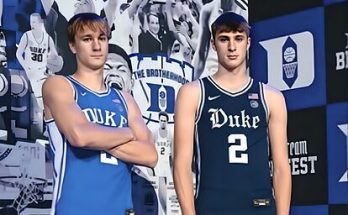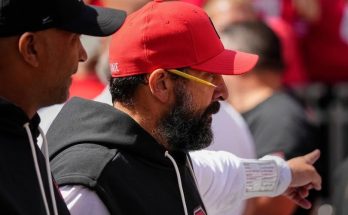The college basketball world never fails to capture headlines when a former five-star recruit makes a decision to return to the collegiate ranks, especially when that player’s journey intersects with a program as storied and scrutinized as Duke University. Recently, a former five-star prospect—once one of the most celebrated names in high school basketball—has sent a clear, unmistakable message to Duke amid his return to college basketball. This development has reignited conversations about player development, loyalty, and the evolving landscape of college hoops.
The story of this former five-star is one of promise, challenge, and a pursuit of growth that has unfolded under the public eye. Highly touted out of high school, this player entered the college basketball scene with sky-high expectations, seen as a transformative talent capable of altering the trajectory of any program lucky enough to secure his commitment. Duke, with its rich tradition of recruiting elite talent and developing future NBA stars, was naturally a focal point in this narrative. Yet, as his career progressed, the journey proved more complex than many anticipated.
In an era where five-star recruits are viewed as the golden tickets for college programs, the pressure to immediately perform and validate recruiting hype is immense. For this player, initial stints at Duke—or closely tied to the program—presented challenges. From adjusting to the heightened physicality and pace of college basketball to navigating coaching expectations and the spotlight that comes with wearing Duke blue, the road was not without bumps. Some questioned whether the fit was ideal, others debated if patience was warranted, but through it all, the player’s talent remained undeniable.
The decision to step away from college basketball, whether to explore professional avenues, transfer, or pursue other opportunities, is not uncommon for elite recruits today. The allure of the NBA, G League, overseas play, or even non-basketball endeavors often lures young stars away from the collegiate scene earlier than in previous decades. This phenomenon has prompted college programs, including Duke, to continuously adapt their strategies around player retention, development, and meeting the evolving needs of modern athletes.
What makes the recent news especially compelling is that this former five-star is making a return to college basketball—not just anywhere, but sending a pointed message that resonates directly with Duke. While the exact nuances of that message are layered, the core sentiment is clear: the journey isn’t over, and there’s unfinished business that demands attention.
The player’s return signals a readiness to embrace the college game anew, armed with experience and a renewed focus. It reflects maturity gained from time away—whether it was spent honing skills, gaining professional-level insights, or simply reflecting on personal goals. Returning to college basketball in this context is not merely a fallback or default option; it’s a deliberate choice to confront challenges head-on and capitalize on the platform that only college hoops can offer.
For Duke, the implications of this message are multifaceted. On one hand, it’s a reminder of the program’s ability to attract and re-engage top-tier talent. Duke’s legacy as a destination for elite players remains intact, bolstered by its track record of preparing athletes for the next level. On the other hand, it serves as a call to action—a prompt to continually evolve in supporting players’ growth, both on and off the court, ensuring their paths align with long-term success and well-being.
This situation also highlights the broader dynamics within college basketball, where player movement and career decisions are increasingly fluid. The traditional model of a one-and-done recruit or a four-year collegiate career is being reshaped by NIL opportunities, transfer portal freedom, and the global reach of professional basketball. In this landscape, programs must balance competitiveness with compassion, ambition with empathy, crafting environments that honor the aspirations of athletes while sustaining team cohesion.
The message sent by the former five-star also underscores the importance of resilience. Returning to college basketball after a hiatus or detour is no small feat. It requires overcoming doubts—both internal and external—and recommitting to the grind. For the player, this return is a testament to a deep-seated passion for the game and a belief in the college experience as a vital step in their basketball journey.
From a fan perspective, this narrative adds layers of intrigue and hope. Supporters of Duke and college basketball at large appreciate the drama of redemption arcs and the promise of untapped potential being realized. The return of a former five-star sparks excitement for what could be a defining season—not just in terms of wins and losses, but in the personal growth and leadership the player can embody.
Moreover, this story reinforces the evolving relationship between players and programs. Communication and trust are paramount. When a player sends a clear message amid their return, it invites dialogue and collaboration—signaling that success is a shared endeavor requiring mutual respect and commitment.
In the grand tapestry of college basketball, moments like these stand out. They remind us that beyond the stats, the rankings, and the highlight reels, lies the human element—the journey of young athletes navigating dreams, setbacks, and triumphs. The former five-star’s decision to return and address Duke so directly is emblematic of this deeply personal and impactful journey.
As the new season approaches, eyes will be keenly watching to see how this player’s return influences Duke’s fortunes and culture. Will this signal a new chapter of leadership and excellence for the program? Will it inspire other players facing crossroads to recommit and chase their goals with renewed vigor? Only time will tell.
What is certain, however, is that the former five-star’s message to Duke is more than just words. It is a declaration of intent, a statement of purpose, and a beacon of what college basketball still represents in the modern era—a place where talent meets opportunity, where second chances matter, and where legacies are forged.
For Duke, the opportunity to embrace this moment and harness the energy of this player’s return could be transformative. For the player, the path back to the court offers a stage to write the next chapter of their story—one defined not only by skill but by courage, perseverance, and a clear vision of what they want to achieve.
In the end, this saga is about more than a single individual or a single program. It is a reflection of the shifting tides in college athletics, a reminder that beneath the surface of recruiting rankings and media narratives lie powerful stories of growth, identity, and the enduring love of the game. The former five-star’s return and message to Duke encapsulate all of this, providing a compelling narrative that will resonate well beyond the hardwood.



